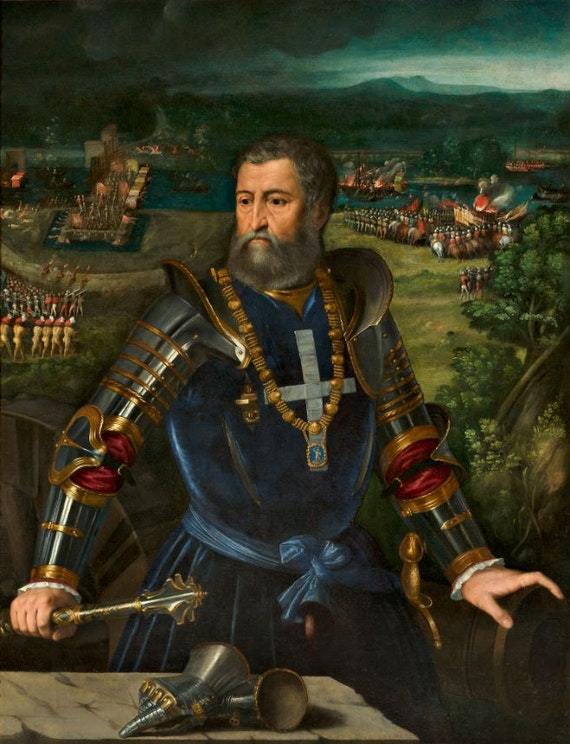#late medieval
Notable Holy Roman Commanders in the War of the League of Cognac (1526-1530)
The Italians Wars as a whole mark some of the most chaotic times the region has experienced. The Italian states at the time were ravaged by consistent infighting, French and Holy Roman incursion, Papal attempts at dominance, and eventually Ottoman Turkish interference. This maelstrom of war lasted nearly 70 years and was characterised by intense bursts of conflict that devastated the region. Powerful commanders, however, were forged in the unforgiving crucible that was war-torn Italy and today I will be highlighting some from just this small segment in the entire overarching conflict.
The conflict began as a direct result of the French loss in the previous war (lasting from 1521-1525). The French had decisively lost at Pavia and Lombardy as a whole which prompted Pope Clement VIII to arrange a formal league led by the pride-damaged French but which also included the Republic of Florence, the Duchy of Milan, the Republic of Venice, and the Republic of Genoa. The Kingdom of England and Kingdom of Navarre played a small, but present role as well. Opposing this League was the Holy Roman Empire and its holdings in Spain and Sicily.
Here are some of the Holy Roman/Imperial German leaders in the War of the League of Cognac.

Alfonso d'Avalos, Marchese del Vasto. Painted by Titian in very early 1533. Housed in the J. Paul Getty Museum. Alfonso d’Avalos fought on the Imperial German side under Emperor Charles V and was appointed governor of Milan after it was seized from the Sforza family on the League’s side. He was commanded by Imperial Lieutenant of Naples, Don Hugo de Moncad, and was instrumental in the utter defeat of League forces outside of Naples in 1528. Further, for his actions he was inducted into the Order of the Golden Fleece.

Alfonso I d'Este, Duke of Ferrara. Painted by Battista Dossi (the sibling of Dosso Dossi) between 1534-1536. Housed in the Gallerie Estensi. Alfonso I d’Este had a very poor relationship with the Papacy even before this war. In 1510, Pope Julius II had excommunicated d’Este to annex his territories into Papal control. d’Este had then gone on to fight against the Papacy in the previous wars and eventually sided with Emperor Charles V as the French wanted to validate Papal claims on Ferrara.

Charles III, Duke of Bourbon. Painted sometime in the 16th century by an unknown artist. Housed in the Parc & Château de Beauregard. Charles had fought for the French for most of his career as Constable, but had severe disagreements with his treatment by King Francis I. For this, Charles conspired against Francis and defected to the Imperial German forces in 1523. Charles received a very diverse army of Italians, Germans, and Spaniards but faced grave issues regarding payment of troops (many of whom were mercenaries) and issues around food supply. His failure to control his forces resulted in the marching to Rome where he was shot and killed outside the walls which then triggered the impromptu Sack of Rome in 1527.

Ferrante I Gonzaga. Painted sometime in the 16th century by an unknown artist. I could not locate where it is housed. Gonzaga succeeded Charles III de Bourbon and was promoted to commander-in-chief of the Imperial German forces in Italy. Further, he was captain-general of the Imperial light cavalry with which he ruthlessly harassed and ambushed League forces successfully for the entire campaign. His creative and bold use of light cavalry as a critical instrument of this new mobile warfare led to him becoming a knight of the Order of the Golden Fleece in 1531 and eventually governor of the Duchy of Milan. Gonzaga was part of the forces with the Prince of Orange that crushed League forces outside of Naples in 1528.









a moment in the woods // 1400s

a pike. a sword. a flag // 1400s
late 14th or early 15th century (1392-1410) Slovenia?
Saint Elizabeth of Thuringia - detail of a fresco in the parish church of St. Martin in Martjanci, Slovenia; by workshop of Johannes von Aquila
http://tethys.imareal.oeaw.ac.at/realonline/
no. 011000
Post link







I’m handsewing a 15th century Italian style doublet for the medieval festival in Provins this June ! Here are some process pics and some of my original references !
This is my first time both handsewing a whole garment and drafting my own mockup so it’s far from perfect but I’m already quite proud of how it’s turning out :D I’ll post updates as it goes. Onto the lining !




